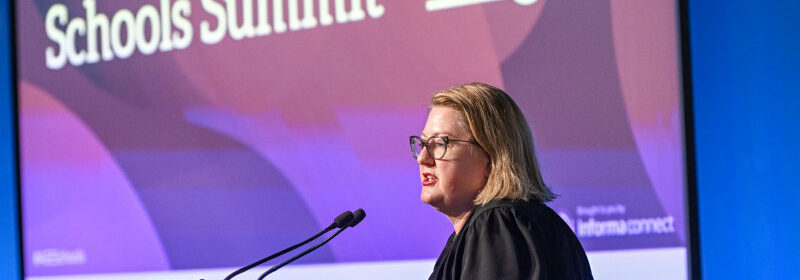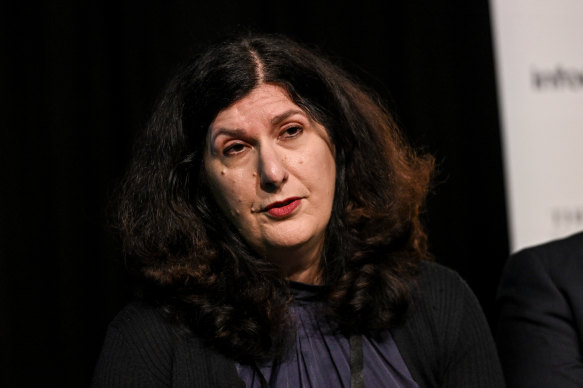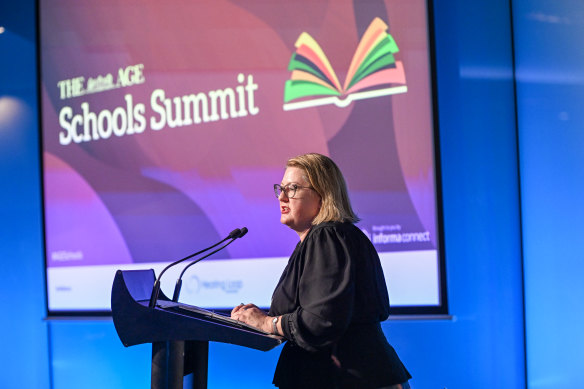Top teachers urge better pay, flexibility to address staff shortages in schools

An estimated 15 per cent of available places in teaching courses at Australian universities are going unfilled, as school-leavers steer clear of a vocation they perceive as inflexible and poorly paid.
School and university education leaders say teaching is a rewarding career, but the industry needs to respond to changing attitudes about workplace flexibility, such as a desire to work from home, and offer salaries that match the rising cost of living.
The Age Schools Summit was held at the Grand Hyatt in Melbourne on March 23.Credit:Justin McManus
An expert panel on Australia’s teaching workforce this week proposed radical changes to educating aspiring teachers in universities to boost the status of the profession among school-leavers, including setting a minimum ATAR for teaching to 80 – up from 70 in Victoria – and introducing publicly reported benchmarks on attrition rates and graduate diversity.
The subject of teacher shortages dominated discussion at the fourth annual The Age Schools Summit, held in Melbourne on Thursday.
The head of one of Victoria’s leading teacher education schools said the staffing crisis in Australia was one of quantity, not quality.
The current crop of teaching graduates was high-quality, but there was not nearly enough of them, said Professor Jim Watterston, dean of the University of Melbourne’s Graduate School of Education.
“Most of our universities are down 15 per cent in terms of entrants. There are 4000 to 6000 positions still available across the country, across 10,000 schools,” he said.
“Most of those schools don’t have a full complement of teachers.”
Speaking at the summit, Watterston said a rethink was needed on what a teacher’s lifestyle and workload was if the sector was to attract more people to the profession.
“It’s a really difficult time to attract students into teaching because there are so many other options out there,” he said.
Edgars Creek Secondary College principal Joanne Camozzato at The Age Schools Summit on Thursday.Credit:Justin McManus
Watterston said teacher salaries made it difficult for them to afford to live in their communities, and beefing pay up would attract more people to the job.
Panellist Joanne Camozzato, the principal Edgars Creek Secondary College in Wollert – one of Melbourne’s fastest growing schools – said many graduate teachers were influenced by their friends’ more flexible and often higher-paying careers.
“They have friends who can work from home one or two days a week, even three days a week,” Camozzato said.
“They have friends who want leave without pay to go to a music festival or to travel overseas for a friend’s birthday and that’s OK. They don’t have a principal or manager sitting across the table looking aghast saying, ‘But you have students and we have a commitment to teaching them’.”
Camozzato has 45 early-career teachers at her growth-corridor school in Melbourne’s northern fringe who have worked in the profession for less than three years.
Her school requires the recruitment of dozens of extra teachers each year. It hired more than 30 for this year, some of whom left within months.
“I have had some teachers leave already this term,” she said.
There were about 900 teacher vacancies in government schools early this week, several weeks into term one.
Victorian Education Minister Natalie Hutchins said school teaching shortages are unevenly distributed.Credit:Justin McManus
Education Minister Natalie Hutchins said the vacancies equate to about one per school, but the shortage was unevenly distributed.
Some schools have a full staff allocation, while others – particularly in outer suburban and regional areas – have a high number of vacancies. There are also shortages in certain subject areas, including maths, sciences and languages.
Hutchins said the department was reaching out to registered teachers who were not currently teaching, and had also registered 2000 new teachers.
“It’s a jigsaw puzzle in terms of solutions,” she said, pointing out that 12 schools had opened at the start of this year, with another 14 to open next year. “That’s a big workforce to plug into schools.”
Government school teachers this year won a 90-minute cut to face-to-face teaching hours, requiring the hiring of an extra 1900 teachers.
Andrea Del Monaco, the Department of Education’s deputy secretary of the schools workforce group, said government and independent schools were competing for staff, but independents could make faster hiring decisions.
Del Monaco said the department’s “clunky” online system took 14 days to process applications for state school teachers.
Independent Education Union deputy secretary David Brear said Catholic and independent schools were also struggling to fill vacancies.
Many schools were putting a teacher in front of every classroom, but whether the teacher was qualified to lead the subject in question was another matter, Brear said.
The Morning Edition newsletter is our guide to the day’s most important and interesting stories, analysis and insights. Sign up here.
Most Viewed in National
From our partners
Source: Read Full Article


